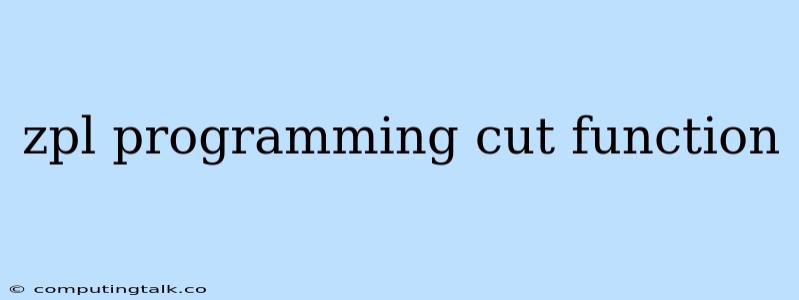Understanding and Using the Cut Function in ZPL Programming
ZPL (Zebra Programming Language) is a powerful tool for creating custom label designs and functionalities. The cut function is an essential part of this language, allowing you to precisely control where your labels are cut after printing. This article will delve into the intricacies of using the cut function in ZPL, explaining its purpose, syntax, and practical applications.
What is the Cut Function in ZPL?
The cut function in ZPL provides a mechanism for automating the cutting process of labels after printing. This function is crucial for creating labels with specific dimensions, separating multiple labels on a single roll, or simply ensuring clean edges on your printed labels.
How does the Cut Function Work?
The cut function works by sending specific commands to the printer, instructing it to activate its internal cutter mechanism. The command itself is relatively simple and follows a specific syntax.
Syntax:
^XA
^CF0,20,20
^XZ
This code snippet demonstrates a basic cut function implementation. Let's break down each element:
- ^XA: This is the start of the ZPL command sequence.
- ^CF0,20,20: This is the cut function command. It defines the type of cut and its parameters:
- 0: Represents the cut type. In this case, it signifies a partial cut, which is a cut that goes through only part of the label, leaving it attached to the roll.
- 20: Represents the cut mode, which specifies the cutting depth. 20 in this case indicates a partial cut where the label is cut through the entire width of the label.
- 20: Represents the cut direction, which defines the direction the cutter will move. 20 indicates a cut from left to right.
- ^XZ: This is the end of the ZPL command sequence.
Types of Cut Functions
ZPL offers various cut types for different scenarios. The most common ones are:
- Partial Cut: This type of cut cuts the label through the entire width but leaves it attached to the roll. This is commonly used for creating multiple labels on a single roll.
- Full Cut: This type of cut cuts the label completely from the roll, creating a single label that can be easily peeled off. This is useful for individual label creation.
- Custom Cut: This type of cut offers more granular control over the cut process. It allows you to specify the cut length, direction, and position within the label.
Key Considerations for Using the Cut Function
While using the cut function in ZPL is straightforward, some key considerations can help optimize your label design and printing:
- Label Material: The type of label material used can affect the cut quality. Ensure your label stock is compatible with your printer's cutter.
- Label Width: When using a partial cut, ensure the label width is greater than the desired cut depth. This ensures the label remains attached to the roll.
- Cut Depth: The cut depth determines the amount of label material removed. It's crucial to select the appropriate depth based on your label design and application.
- Cut Direction: The cut direction can be crucial depending on the label's orientation and the way it needs to be peeled off or dispensed.
Examples of Implementing the Cut Function
Example 1: Full Cut
^XA
^CF1,20,20
^XZ
This code snippet implements a full cut with the following parameters:
- 1: Represents a full cut, which completely separates the label from the roll.
- 20: Represents the cut mode, indicating a cut through the entire width of the label.
- 20: Represents the cut direction, which is left to right.
Example 2: Partial Cut with Custom Length
^XA
^CF0,20,10
^XZ
This code snippet demonstrates a partial cut with a specific length:
- 0: Represents a partial cut.
- 20: Represents the cut mode, signifying a full-width cut.
- 10: Represents the cut depth, defining the length of the cut.
Troubleshooting Cut Function Issues
If you encounter issues with the cut function, consider the following:
- Printer Compatibility: Ensure your printer is compatible with the cut function. Consult your printer's manual or online documentation for specific requirements.
- Driver Settings: Check your printer driver settings to ensure they support the required cut function parameters.
- ZPL Syntax: Verify the syntax of your cut function command to eliminate any errors.
- Label Material: Ensure your label material is compatible with your printer's cutter.
- Cutter Blade: Inspect your cutter blade for sharpness and damage. A dull or damaged blade can affect the cut quality.
Conclusion
The cut function in ZPL is an essential tool for controlling label cutting in your printing process. Understanding the different cut types, their parameters, and potential issues can help you create labels with precision and ease. By mastering the cut function, you can optimize your label design, improve efficiency, and achieve the desired results for your specific application.
